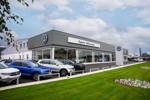When chief executive Jean-Martin Folz came to London for the 2005 financial results, he said that he would sell four million cars by 2009.
That means a growth of 4% in volume every year. Yet last year, when the markets were competitive and declining slightly, the company managed a growth of only a tenth of the target rate.
The promised strategy is clearly a gamble – and all the more so given that its compatriot, Renault, has an identical target of rapid growth to four million vehicles a year by 2009.
Having enjoyed an operating margin of 4.4% in 2004, PSA has been unhappy to announce a fall to 3.4% last year.
In the second half of the year, it was down to 2.8% and the current thinking on this year is that it will be same again in the first half of 2006.
A major issue for the company is the rising cost of steel and oil (the base component of plastic). But there have been one-offs like the cost of complying with new vehicle regulations under Euro IV.
At Ryton in the UK, there was a payment of £16m to pay off the night shift to adjust for the falling demand for the maturing 206.
Folz admits that he carried out a full review of the company’s strategy after the results were in, to confirm that the board still believed in the strategy. He’s happy that the plan for growth to be funded by cost saving with platform commonalization between the twin-brand policy of Peugeot and Citroën, plus model development ventures with other carmakers, is the right one.
Toyota, BMW, Ford, Fiat, DaimlerChrysler and Mitsubishi are now all engineering partners. Dealers in the UK may be in for a tough year as Peugeot Citroën pushes for both volume and margin – especially with Renault doing the same thing.













Login to comment
Comments
No comments have been made yet.